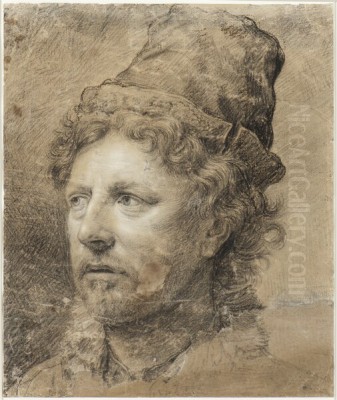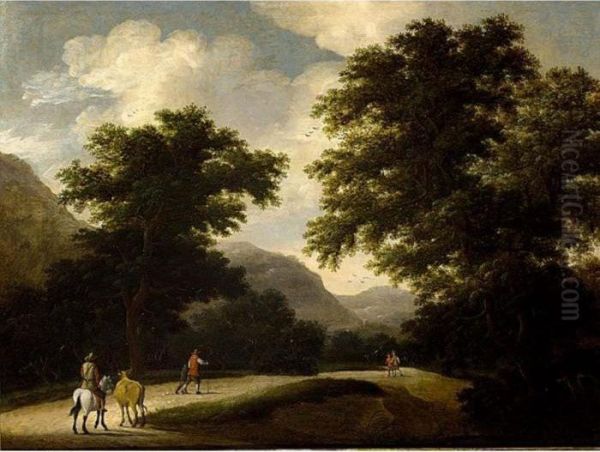
Anthonie Waterloo stands as a significant, though sometimes overlooked, figure in the rich tapestry of Dutch Golden Age art. Active during the 17th century, a period renowned for its explosion of artistic talent and innovation in the Dutch Republic, Waterloo carved a distinct niche for himself primarily as a draughtsman and etcher of landscapes. While perhaps not achieving the household recognition of contemporaries like Rembrandt or Jacob van Ruisdael, Waterloo's dedicated focus on the natural world, particularly the intricate beauty of trees and forests, resulted in a body of work admired for its sensitivity, technical skill, and enduring atmospheric power.
From Lille to the Dutch Republic
Anthonie Waterloo's story begins not in Holland, but in Lille (known then as Ryssel), a city located in the Southern Netherlands (now part of France). Born around 1609 or 1610 into a family reportedly involved in the cloth trade, his early life unfolded against a backdrop of political and religious tension. His grandfather was named Caspar Waterloo. Precise details about his artistic training remain elusive; no records definitively name his teachers. It is plausible he received initial instruction within his family circle or through local connections.
Like many others from the southern provinces during this era, Waterloo eventually migrated north to the more tolerant Dutch Republic. Sources suggest this move may have been prompted by religious persecution, a common motivation for relocation at the time. He appears to have settled initially in Amsterdam, the bustling heart of the Dutch commercial and artistic world, likely by the late 1630s.
This relocation placed him amidst a thriving artistic community. Amsterdam was a crucible of talent, where artists explored new genres and techniques. For a landscape artist like Waterloo, the Dutch environment, both urban and rural, offered abundant inspiration, even as he developed his particular affinity for woodland scenes.
Establishing a Life and Art in Holland

In 1640, while likely residing in Amsterdam, Anthonie Waterloo married Catharina Stevens van den Dorp. Catharina was the widow of another artist, Elias van der Hooghe (also referred to as Emil Hoes in some sources). This union brought Waterloo not only companionship but potentially a connection to the existing art world infrastructure. Some accounts suggest Catharina may have been involved in art dealing, which could have provided practical support for Waterloo's burgeoning career. The couple would go on to have six children.
During his time in Amsterdam and later Utrecht, Waterloo honed his skills as both a painter and, more prolifically, an etcher and draughtsman. While documented paintings by his hand are relatively scarce, his output of drawings and etchings was considerable. He developed a distinctive approach to landscape, often focusing on the intimate corners of nature rather than grand, panoramic vistas.
His artistic development was undoubtedly shaped by the work of other artists active in the Dutch Republic. He is thought to have been influenced by the detailed naturalism of Roelandt Savery, an earlier artist known for his depictions of flora and fauna. More significantly, the profound and atmospheric woodland scenes of Jacob van Ruisdael, a leading landscape painter of the generation, likely resonated with Waterloo's own artistic inclinations.
Master of the Etched Landscape
While Waterloo did produce paintings, his most significant contribution lies in the medium of etching. He became exceptionally proficient, creating a large body of work – estimates suggest over 130 distinct plates. Etching, a printmaking technique allowing for fine lines and tonal variations, proved perfectly suited to his detailed explorations of the natural world.
His technique was characterized by meticulous attention to detail, particularly in the rendering of foliage, bark, and the play of light filtering through trees. He often employed fine, sometimes stippled, lines to build up texture and create a sense of depth and atmosphere. His drawings, frequently executed in black chalk or charcoal, often enhanced with grey wash and white chalk highlights, display a similar sensitivity to light and texture, capturing the dynamic forms of trees and the quiet solitude of the woods.
Unlike the dramatic etchings of Rembrandt van Rijn, which often explored biblical or historical themes alongside landscapes, Waterloo remained steadfastly focused on the natural scene. His work also differs from the innovative, almost experimental, landscape etchings of Hercules Segers. Waterloo's strength lay in his consistent, sensitive observation and his ability to translate the textures and moods of the forest into the linear language of etching.
The Allure of the Forest
The dominant theme throughout Anthonie Waterloo's oeuvre is the forest. He seemed endlessly fascinated by trees – ancient oaks with gnarled branches, slender birches clustered by a stream, dense thickets creating patterns of light and shadow. His landscapes often feature winding paths leading the viewer into the woods, small clearings, tranquil ponds, or rustic cottages nestled amongst the trees. Figures, when they appear, are usually small, serving to emphasize the scale and quiet majesty of nature.
His depictions range from serene, idyllic woodland scenes to more rugged, untamed landscapes featuring rocky outcrops and rushing water. He captured the varying moods of the forest, from the peaceful stillness of a sun-dappled clearing to the slightly melancholic atmosphere of a dense, shaded wood. This focus set him apart from contemporaries like Jan van Goyen or Salomon van Ruysdael, who often specialized in river views and panoramic dune landscapes, or Aelbert Cuyp, celebrated for his depictions of the Dutch countryside bathed in golden light.
Waterloo's subject matter was enriched by his travels. He is known to have journeyed through various parts of the Netherlands, both north and south. Evidence suggests he also traveled along the Rhine River into Germany, and possibly visited regions further east, perhaps even towards Poland, although details are scarce. An Italian journey has also been suggested, though less firmly documented. These excursions undoubtedly provided him with fresh motifs and perspectives, reflected in the diverse topographies found in his work. The landscapes often feel specific, rooted in observation, even when composed back in the studio.
While primarily known for forests, some sources mention cityscapes (views of Utrecht or Amsterdam) and farming scenes appearing in his work. However, these seem to constitute a minor part of his output compared to his extensive exploration of woodland environments. His contemporary, Jan Vermeer van Haarlem the Younger, also specialized in landscapes, offering another point of comparison within the field. The dramatic, often Scandinavian-inspired, landscapes and etchings of Allart van Everdingen provide another contemporary contrast in landscape focus.
Representative Works and Recognition
Pinpointing specific "masterpieces" among Waterloo's etchings can be challenging, given the consistency of his output. However, certain works and series stand out. His Landscape with Alpheus and Arethusa, an etching created around 1647, is notable. It depicts a mythological scene from Ovid's Metamorphoses set within a characteristic Waterloo landscape, showcasing his ability to integrate narrative elements into his natural settings. This print is held in collections such as The Metropolitan Museum of Art in New York.
His etchings were often published in series, grouped by theme or size. The renowned 18th-century print cataloguer Adam von Bartsch documented 136 of Waterloo's etchings in his seminal work, Le Peintre Graveur (published from 1803, though Bartsch compiled earlier catalogues including one from 1795 specifically on Waterloo). These catalogue numbers (e.g., Bartsch 1, Bartsch 112) are still used today to identify his prints. The subjects listed by Bartsch confirm his focus: series of upright landscapes, oblong landscapes, views of villages, river scenes, and forest interiors dominate the list.
Despite the quality of his work, Waterloo's paintings remain relatively rare. This scarcity, compared to the abundance of his prints, suggests that etching and drawing were his primary modes of expression and perhaps his main source of income. It's possible his wife's potential involvement in art dealing facilitated the sale and distribution of his popular etchings.
Later Years and Enduring Influence
Around 1653, Waterloo and his family moved from Amsterdam to Leiden, another important Dutch city. Later, they relocated again, settling in Utrecht, where he seems to have spent a significant portion of his later career. Utrecht had its own artistic traditions, notably influenced by the Italianate landscape painters, though Waterloo largely maintained his distinctively Northern European style.
His wife Catharina passed away in 1674. Following her death, Waterloo reportedly moved to Maarssen, a town near Utrecht, before eventually returning to Utrecht itself. He lived a remarkably long life for the era, passing away in Utrecht in 1690, likely aged around 80.
While perhaps not a major innovator on the scale of Rembrandt or Jacob van Ruisdael, Waterloo's influence was felt, particularly through his widely circulated etchings. In the 18th century, his prints were highly sought after by collectors across Europe. His detailed yet atmospheric depictions of nature resonated with the developing sensibilities of landscape appreciation. French artists, in particular, seem to have admired his work. His focus on naturalistic forest scenes is seen as a precursor to the interests of the 19th-century Barbizon School painters in France, such as Théodore Rousseau, who championed direct observation of nature.
The publication of Adam von Bartsch's catalogue raisonné of his etchings in 1795 solidified Waterloo's place in art history and further stimulated interest among collectors and connoisseurs. It marked him as an early master whose print oeuvre was worthy of systematic study.
Waterloo in Collections Today
Works by Anthonie Waterloo, primarily his etchings and drawings, are held in major print rooms and museum collections around the world. Besides The Metropolitan Museum of Art, significant holdings can be found at the Rijksmuseum in Amsterdam, the British Museum in London, the National Gallery of Art in Washington D.C., the Albertina in Vienna, the Bibliothèque Nationale de France in Paris, and many other institutions renowned for their collections of Old Master prints and drawings. His paintings appear occasionally in museum collections and on the art market.
These collections allow contemporary audiences to appreciate the quiet mastery of Anthonie Waterloo. His works offer a window into the 17th-century Dutch landscape, rendered with a distinctive blend of detailed observation and poetic sensibility.
Conclusion: A Legacy in Leaves and Light
Anthonie Waterloo dedicated his long artistic career to capturing the essence of the natural world, particularly the intricate beauty and quiet solitude of forests. As a draughtsman and especially as an etcher, he developed a distinctive style characterized by meticulous detail, sensitive handling of light and shadow, and a profound feeling for atmosphere. Though perhaps overshadowed in fame by some of his Dutch Golden Age contemporaries like Meindert Hobbema or Rembrandt, his substantial body of etched work secured his reputation.
His move from the Southern Netherlands, his life and family in Amsterdam and Utrecht, and his travels through the Dutch and German countryside all informed his art. Influenced by artists like Roelandt Savery and Jacob van Ruisdael, he nonetheless forged his own path, focusing intently on the sylvan landscape. His etchings, popular in his own time and highly collected in the centuries that followed, influenced subsequent generations of landscape artists and continue to be admired for their technical skill and evocative power. Anthonie Waterloo remains a key figure for understanding the depth and diversity of Dutch landscape art, a master whose legacy is etched in the delicate rendering of leaves, branches, and the enduring light of the forest.